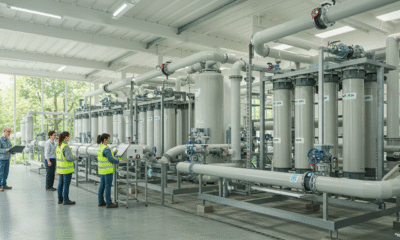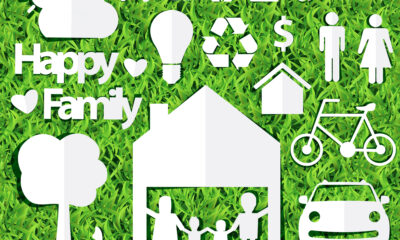

Features
A Closer Look at Sustainability in the Facial Aesthetics Industry
Since Ryan took over as the head of Blue and Green Tomorrow, we have shifted the focus of the blog heavily toward sustainability in industries that often go unnoticed, including facial aesthetics. You might not immediately connect eco-friendly practices with beauty clinics or cosmetic producers, but the shift is already underway.
Lola Kurnia Pitaloka published a study showing green cosmetics are already present throughout the market, but green cosmetics enthusiasts make up about 25% of consumers, and that number is growing. It is becoming clear that demand for sustainable options in beauty treatments is climbing year after year. Keep reading to learn more.
Consumers Are Pushing for Greener Options
Earlier this year The Roundup reported that 62% of people say they “always or often” seek products to purchase because they are sustainable for the environment. You may see this reflected in clinics that now advertise biodegradable packaging or energy-conscious equipment. This is one of the many ways companeis are focusing on green cosmetics.
There are powerful reasons why people choose greener facial products. It is about both personal health and environmental impact. You are less likely to attract eco-conscious clients if your services rely on wasteful or polluting methods.
PwC released a report last year showing more than four out five of consumers say they are willing to pay more for sustainably produced or sourced goods. You should think carefully about how this affects the pricing models of facial aesthetics providers. There are many ways eco-focused clinics can justify a premium when their practices meet the expectations of a growing majority.
It is no longer enough for clinics to focus only on short-term trends in aesthetics. You will win more loyalty by proving a commitment to long-term environmental responsibility. There are strong market signals that those who ignore sustainability risk losing relevance in the industry.
You can see clear gaps between consumer demand and what providers actually deliver. It is troubling that only a fraction of the industry has fully embraced green sourcing. There are still many suppliers relying on packaging and formulas that harm the planet.
It is reassuring, however, that awareness is rising on all sides. You are part of a sector where beauty and sustainability intersect in meaningful ways. There are opportunities to show leadership by sourcing products responsibly, reducing waste, and speaking to eco-conscious values.
The facial aesthetics industry has grown rapidly over the past decade, with treatments such as dermal fillers, Botox, skin rejuvenation, and non-surgical facelifts becoming increasingly popular. While this growth brings economic benefits and wider access to aesthetic treatments, it also raises important questions about sustainability. From the production of treatment materials to waste management in clinics, the industry faces a responsibility to minimise its environmental footprint. As global awareness of climate change and resource conservation grows, sustainability in the facial aesthetics industry is no longer a niche topic—it is a necessity.
Understanding Sustainability in Aesthetics
In the context of facial aesthetics, sustainability refers to the industry’s ability to deliver high-quality treatments without depleting natural resources, generating excessive waste, or contributing significantly to environmental harm. This involves considering every stage of the treatment process, how products are made, how they are packaged, how waste is managed, and how clinics operate on a day-to-day basis.
For an industry rooted in enhancing beauty, there is a strong alignment between sustainability and its core values: both are about preserving and improving what exists, whether it’s a person’s skin health or the planet’s natural resources.
Environmental Impact of the Industry
Facial aesthetics may seem relatively low-impact compared to manufacturing-heavy sectors, but it still generates significant environmental pressures. These include:
(i) Single-use plastics – Syringes, gloves, packaging, and treatment applicators are often disposable for hygiene and safety reasons.
(ii) Chemical waste – Certain skincare products and injectable substances require careful disposal to avoid environmental contamination.
(iii) Energy consumption – Laser and light-based treatments consume substantial electricity, particularly in high-traffic clinics.
(iv) Transportation emissions – Importing products and equipment from global suppliers increases the industry’s carbon footprint.
Addressing these areas is crucial for creating a greener, more sustainable industry.
Sustainable Product Sourcing
One of the most impactful ways to improve sustainability is through ethical and eco-friendly product sourcing. Manufacturers of dermal fillers, Botox, and skincare lines are beginning to adopt greener practices, such as:
-Using biodegradable or recyclable packaging to reduce plastic waste.
-Sourcing ingredients from sustainable farms that avoid harmful pesticides and over-farming.
-Ensuring ethical supply chains, where production processes meet environmental and labour standards.
Facial aesthetics clinics can support these initiatives by choosing suppliers who commit to sustainability and by informing clients about the eco-friendly benefits of the products they use.
Reducing Single-Use Waste
Hygiene requirements in the aesthetics sector mean many tools and containers must be sterile and disposable. However, innovation in medical-grade reusable equipment and biodegradable materials is helping reduce reliance on single-use plastics.
For example:
-Biodegradable gloves and wipes are becoming available, offering the same safety without long-term environmental impact.
-Compostable packaging for aftercare products can replace traditional plastic containers.
-Recycling schemes for hard-to-dispose-of medical plastics are emerging in some regions.
Even small changes, such as switching to paper-based patient forms or digital consent systems, can significantly cut down on waste.
Energy Efficiency in Clinics
Sustainability in facial aesthetics is not only about products but also about how clinics are run. Reducing energy consumption is an area where many businesses can make quick and cost-effective improvements.
Steps include:
-Switching to LED lighting to lower energy usage.
-Installing energy-efficient heating and cooling systems, which are vital in treatment rooms.
-Scheduling treatments to maximise equipment use in a single session rather than powering devices on and off multiple times a day.
-Investing in renewable energy sources, such as solar panels, where feasible.
Not only does this reduce environmental impact, but it also lowers operating costs over time.
Waste Disposal and Recycling
Proper waste disposal is a critical issue in the facial aesthetics sector due to the presence of clinical and chemical waste. Adopting eco-friendly waste management systems can ensure safety while supporting sustainability goals.
Best practices include:
-Partnering with licensed medical waste disposal companies that recycle where possible.
-Using separate bins for recyclable materials, non-recyclables, and hazardous waste.
-Training staff on correct disposal methods to ensure compliance with both environmental and health regulations.
Sustainable Packaging for Aftercare Products
Aftercare is a major part of facial aesthetics, with clients often purchasing skincare products to maintain results. These items, however, are traditionally sold in plastic bottles, tubes, and jars.
Innovative alternatives include:
-Glass containers that can be reused or recycled.
-Refill stations for creams and serums in clinics.
-Minimalist packaging that uses fewer materials overall.
By offering sustainable aftercare products, clinics not only reduce waste but also appeal to eco-conscious clients.
Digital Transformation for Paper Reduction
A surprising source of waste in aesthetics clinics is paper—patient records, appointment reminders, consent forms, and promotional materials. Moving to a digital-first system offers multiple benefits:
-Electronic medical records save paper and allow easy access to patient histories.
-Email or app-based appointment reminders reduce reliance on printed cards.
-Digital brochures can replace physical marketing materials, cutting down on printing costs and paper waste.
The Role of Industry Standards and Regulation
For sustainability to become the norm in the facial aesthetics industry, it needs support from professional bodies and regulators. Industry-wide guidelines could help standardise eco-friendly practices, such as:
-Minimum requirements for waste management.
-Encouragement of ethical sourcing in product manufacturing.
-Benchmarks for carbon footprint reduction in clinics.
Regulatory frameworks could incentivise clinics to adopt greener operations through tax breaks, recognition schemes, or reduced licensing fees for sustainable practices.
Future Outlook
The future of sustainability in facial aesthetics is promising. Innovations in biodegradable medical plastics, carbon-neutral manufacturing, and energy-efficient treatment technologies are becoming more accessible. As clients increasingly seek providers that align with their environmental values, sustainability could become a competitive advantage.
A forward-thinking clinic that integrates sustainability into its brand identity will not only reduce its environmental impact but also stand out in a crowded marketplace.
The Takeaway
Sustainability in the facial aesthetics industry is about balancing the desire for beauty enhancements with the responsibility to protect the environment. From sourcing ethical products and reducing waste to improving energy efficiency and educating clients, there are numerous opportunities for clinics to make a positive impact. While challenges remain, the growing awareness and demand for eco-conscious services suggest that sustainability will play a central role in the industry’s future. By embracing these changes today, the facial aesthetics sector can help ensure a healthier planet and a brighter future for all.
Sustainability in the facial aesthetics industry is not just about marketing—it is about survival in a market that increasingly rewards responsibility. You are seeing a shift where consumer preference, willingness to pay, and long-term trust all point toward green choices.
It is clear that those who embrace eco-friendly sourcing and practices are positioned for stronger growth. You will benefit from adopting sustainability as a foundation of your aesthetic services, rather than treating it as an afterthought.


 Environment10 months ago
Environment10 months agoAre Polymer Banknotes: an Eco-Friendly Trend or a Groundswell?

 Environment11 months ago
Environment11 months agoEco-Friendly Home Improvements: Top 7 Upgrades for 2025

 Features9 months ago
Features9 months agoEco-Friendly Cryptocurrencies: Sustainable Investment Choices

 Features10 months ago
Features10 months agoEco-Friendly Crypto Traders Must Find the Right Exchange





























